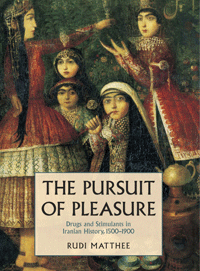Daneshgah-e Melli (National University) is built on the hills overlooking Evin valley. On a hot late-morning, my friend, a former student of Melli University, and I walked up the hill to the entrance. We walked past the old university guard headquarters that was built under the Shah as a security measure against student demonstrations and political rallies. The once dreaded site is now home to families displaced by war. Little boys played soccer with a limp ball and took turns riding a rusty oversized bicycle. The neglected headquarters, now lined with drying laundry, would perhaps have been a welcome sight by the then protesting students, but it remains bitterly ironic in the eyes of the terrorized and veiled new generation of students.
We were turned away at the main entrance to the University on account of our hejab not meeting official standards (the color not dark enough), so we entered through an out-of-the-way gate that my friend remembered. The sturdy and once immaculate buildings of the campus (this used to be, after all, a fashionable university), having gone through seven years of turmoil and disrepair, have turned into mock echoes of the quest for knowledge. The walls silently mirror the noisy rhetoric of the Islamic Republic: "We have no need for non-Islamic institutions" - Imam Khomeini. "Our revolution is a revolution of values" - Imam Khomeini. "The pledge of our academics must be to Islam" - Imam Khomeini.
We walked to the gym and straight on to the southwest porch where we looked down on the wide expanse of Evin prison. A massive brick wall covered with electric barbed wire and punctuated with observation towers continues in and out of sight along the rolling hills, engulfing square miles of desolate space.

The vantage points from which the prison compound has such a panoramic display used to be guarded and kept off-limits by the university guards before the revolution - a situation that provoked the students even more and drove them to despise and abuse the perfectly groomed soccer field and the shining sports equipment that used to fill the various halls of the building. But the Islamic Republic does not insist on keeping secrets. The Imam, addressing his Cabinet during the Week of Government in the summer of 1986, declares: "It does not matter if our economy is bankrupt. The important thing is that Islam is not bankrupt." It is in the same no-secrets spirit that the Republic exposes people to the graveyard of its executed victims and students to the sight of its prisons and even to the sounds of its firing squads.
The panorama of Evin serves for Melli University a function beyond what the site of the
Namaz-e Jom'eh (Friday Prayer) serves for Tehran University. Shortly after the revolution, the soccer field at Tehran University was paved over and turned into the stage for the Friday Prayer. The area is wire-fenced in, facing a painted blue and green and yellow pulpit - a vague landscape of a sky and a sun - displaying a large photograph of Khomeini and smaller ones of the "martyred" Ayatollah Beheshti and Khomeini's then heir Ayatollah Montazeri. Before the mid-day prayer, a semi-automatic-toting preacher high in the power hierarchy - the President, the Speaker of the Parliament, the Prosecutor General, or the like - delivers a sermon or two that set the tone for the social and political atmosphere of the week to follow.
Modeled after the early Islamic display of Moslem unity and power, the Namaz-e Jom'eh in Tehran is a resurrected ritual that in the age of mass-media has increasingly been turned into a spectacle. From dawn each Friday, the streets surrounding the university area are closed off to traffic while thousands of men, women, and children - the umma of Hezbollah - are bused in and arranged in sections and rows designated by special rulings that are regularly repainted on the streets.
The televised broadcast of the image of the
umma in prostration, then on their feet, on cue, stringing a series of "Death to..." slogans and shaking clenched fists into the camera, often finds its way into many a faraway living room. By late afternoon, buses transporting the last groups of women - drenched with sweat underneath their heavy veilings and carrying heat-struck small children - vacate the area, leaving the neighborhood to enjoy a brief respite after hours of blasting speeches and screeching microphones, and before the return of the noise and fumes of the usual traffic. On weekdays, the special rulings on the streets - signifiers of the farcical and violence-infused Namaz-e Jom'eh - blend with unobserved traffic signals into the gridlock of an even larger organization of ignored signs.

The impact of Evin, on the other hand, is that of a referent. The panorama of Evin is not meant to symbolize; and, while accessible to a live audience, the still-life vista is not meant for video cameras.
Two main buildings comprise the prison compound of Evin Prison. A red brick building that was operational under the Shah was "liberated" Bastille-style in 1979, with the intention, people now recall almost with amusement at their own naiveté, of turning it into a museum. Next to it stands a yellowing cement construction about three times larger in size, whose foundation was laid before the revolution and has been speedily completed by the Islamic Republic
>>> Photos
The interior architecture of these buildings is impossible to reconstruct from descriptions. Visitors and prisoners are blindfolded as they are taken inside the buildings or moved about. Those prisoners who are allowed to visit with their families for ten minutes every 45 days across Plexiglas and through telephones, are led to the visiting room in a row, blindfolded, holding on to each others' hands, a rope, or corners of each others' veils. Visitors are screened at an office located in an amusement park ("Luna Park") across the highway from the main area of the prisons, where in the evenings children are treated to their meager, wartime ration of recreation
>>> Part 7
[Part
(1) (2) (3) (4) (5) (6)
(7) (8) (9) (10) (11) (12) (13) (14) (15) (16) (17)]